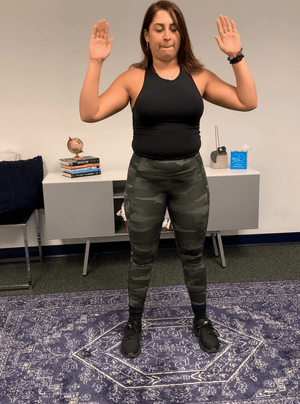PCOS Fitness Guide: The Best Workout for Managing PCOS Symptoms
August 24th, 2023 | 11 min. read
.png?length=550&name=RMACT%20BLOG%20HEADER%20(5).png)
Have PCOS? You've probably heard that physical activity is one of the best ways to manage your symptoms. But what if you're not sure where to start? Enter: our PCOS fitness guide!
In this article:
What is the best workout for PCOS?
That's a great question! Many of us know we should increase our physical activity levels, but simply lack the direction needed to help us incorporate more movement into our daily lives.
In this detailed guide, we'll discuss how exercise impacts your body and helps combat PCOS symptoms, your various movement options, a sample PCOS workout (with helpful visual demonstrations), and the real secret to sticking with a workout routine.
If you're wondering: "Am I working out correctly for PCOS? What if I’ve never worked out before? Where do I even begin?" you're in the right place!
In this beginner PCOS fitness guide, we'll show you exactly how to get started with an easy, no-frills movement practice that will help calm your PCOS symptoms, help you get your energy back, and feel better overall.
The Benefits of Exercise for PCOS
Before we dive in, let’s be perfectly clear...there is no one right way to incorporate regular movement when you have PCOS. There is no magic one-size-fits-all approach. Your body is unique, and so are your preferences.
At the end of the day, it’s about moving your body and doing what feels good to you.
Remember: Start slowly and do what you can. Don't overdo it or set sky-high expectations when you're just getting going. Building habits takes time!
How can exercise help with PCOS?
Did you know? PCOS patients actually have higher levels of anxiety and depression. And as we know, exercise releases some wonderful feel-good hormones, like endorphins and dopamine.
And anyone battling symptoms of PCOS, like insulin resistance, stress, depression, and anxiety can truly benefit from some extra endorphins, right?
What exercise is best for PCOS?
There's a whole lot of conflicting information about PCOS and exercise out there - which can be pretty overwhelming and confusing. However, there are some basic principles that make a workout routine PCOS-friendly:
- It should be specifically designed to work on the large muscle groups, since increasing muscle mass in those areas can also increase your metabolism.
- It should incorporate cardio, which is important for increasing your endorphins (those feel-good hormones mentioned above) and helping to decrease stress and anxiety.
While these two principles are great guideposts, remember that the main goal is to simply get your body moving on a consistent basis!
What counts as exercise?
Not into traditional fitness routines or sweating it out at the gym?
Don't worry! You still have plenty of options for getting your body moving. Maybe that means taking the stairs instead of the elevator, parking further away from a store to get extra steps in, or fitting in one of the activities listed below. Experiment until you find what works for you.
Activities that count as moderate-intensity exercise:
- Yoga classes (we offer free Fertile Yoga!)
- Taking a walk outside
- Dancing it out
- Hiking a trail
- Online workout videos
- Vacuuming or mopping
- Riding a bike
- Mowing the lawn
The Ultimate PCOS Fitness Routine
Now that you know why exercise is so great for reducing PCOS symptoms and how to customize your workout routine, let's dive in to our PCOS fitness routine! You'll find basic written instructions below, as well as visual demonstrations of each move.
Customize Your Workout
As with any form of exercise, feel free to customize it so it fits your needs and fitness level. Is your first time back in the fitness-saddle after awhile? Or do you need to make these exercises more challenging? Here are a few ways you can tailor this workout to you:
Play with Reps
Although the number of suggested repetitions of each exercise are listed below, you should do as many as needed so that the last 5 feel very difficult - like you can barely do them while keeping good form.
For some people that may be 20, for others, it may be 10 or less. Or maybe you’re simply not feeling well one day or need to start off a little lighter.
Listen to your body - lower the number of reps and take it slow when you need to.
Add Weights or Resistance Bands
Modifications and safety guidelines are listed throughout the routine below. The first rule of resistance bands? Make sure there are no rips or tears. That’s a painful rubber band sting waiting to happen...ouch!
Rep, Sweat, Repeat
If you want to amp up the intensity, do this workout more than one time through. Repeat this circuit two or three times for a full 20-minute workout.
Ready to get your body moving? Let's go!
Phase 1: Warm-Up
First, start by waking up your muscles. Do the following movements for 1 minute each, starting with the easiest movement (walking in place), then scale up to the more difficult ones as you go:
- Walk in place
- Walk in place with high knees
- Jumping jacks
Phase 2: Move Your Body
Great! Now you're all warmed up and ready to start the routine. Take a swig of water, put on your favorite playlist, and get ready to sweat!
20 Knee Hugs
Pull each knee up to your chest. Do 20 knee hugs on each side, then rest for 20 seconds.
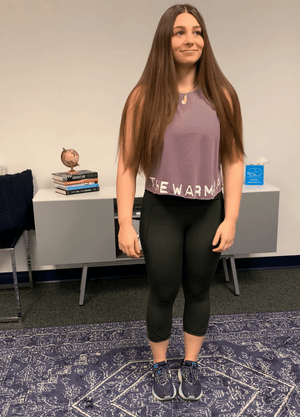
20 Arm Circles
Stand up nice and straight, feet hip-width apart, and slowly circle your arms forward in unison. After you complete your 20 arm circles, rest for 20 seconds.
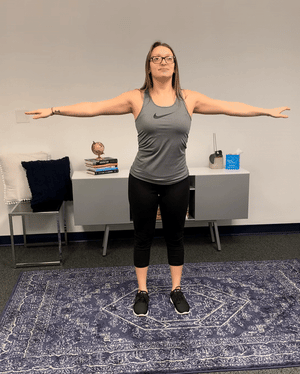
20 Squats
When you're doing your squats, make sure your knees are not in front of your feet (they should be in line with your feet). After 20 squats, rest for 20 seconds.
You're doing awesome! Let's keep going.
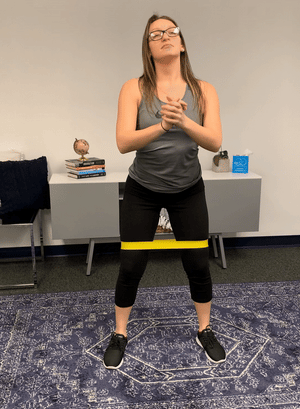
Pro tip: You can add intensity here with weights or a resistance band (as seen above). Make sure you push your booty back, be mindful that your knees never extend out over your toes, and keep your chest up and open.
*If you are using resistance bands or weights, make sure you never lose your form.
20 High Knee Twists
After your high knee twists, take a 20-second rest.
20 Back Turns
After your upright back turns, you guessed it - rest for 20 seconds!
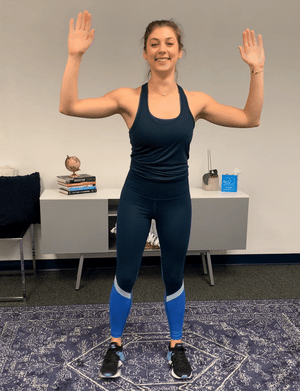
20 Arm Circles
Remember the arm circles we did at the beginning of this PCOS workout? Well, this time, we're circling our arms the opposite way! Once completed, rest for 20 seconds.
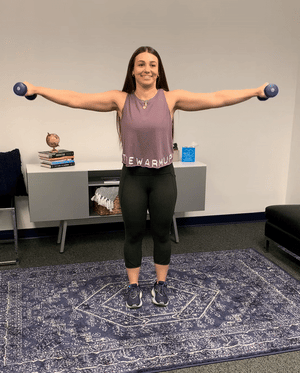
Pro tip: Use light weights to add intensity. Make sure your shoulders always stay square and your tailbone stays in line with your spine.
20 More Squats
Make sure these are nice, deep squats. Once you've completed your 20 squats, rest for 20 seconds. (You're probably starting to look forward to these little rests right about now!)
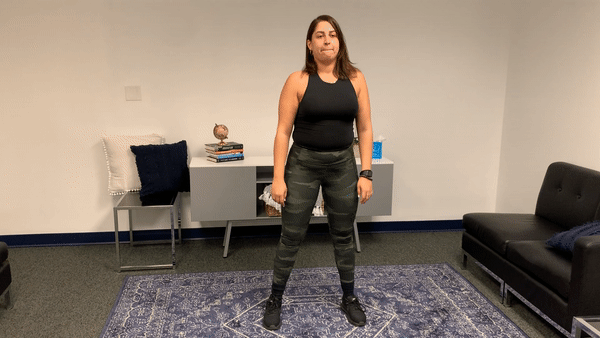
20 Side Bends
Complete your 20 side bends, then rest for 20 seconds. Look at you! You're doing great.
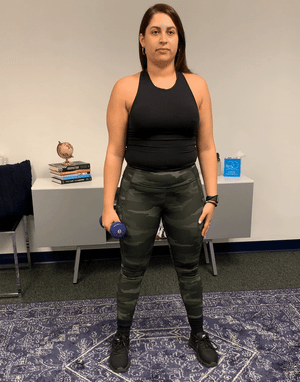
Pro tip: Add a small weight for added intensity. But keep in mind, your form should not suffer because of the added weight - keep those shoulders back and square. Imagine gliding along a wall.
20 More High Knee Twists
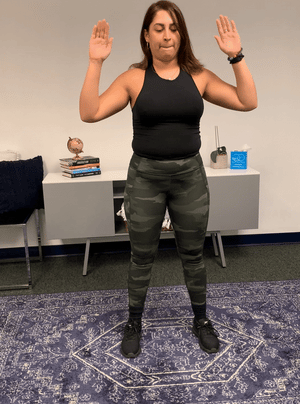
Phase 3: Cool Down
You've made it through your first full PCOS workout circuit! Take a few minutes to stretch, hydrate, and take some deep breaths before repeating the routine (if you're up for it).
As you saw, this PCOS fitness routine is easy to do at home, requires no fancy gym equipment, and is gentle on beginners. Now comes the inevitable question: how do I make myself actually workout consistently? Don't worry - we've got some great ideas for you!
How to Stick to a Workout Routine
It’s great if you got a chance to work out today.
It would be even better if you worked out again tomorrow or the next day.
It would be best if you started a fitness regimen and stuck to it (this is our goal!)
Ideally, we would all work out most days during the week. But that’s hard. There are lots of things that can stand in your way, like schedules, motivation, mental health, illness, travel...the list goes on.
It’s not always easy to form an exercise routine, and it does take time and consistency before it starts becoming second-nature. So, how do we come up with a plan and stick to it? Here are six easy tips that will help you get going:
Tip #1: Stack Your Habits
Research has shown that one great way to form a new habit is to link it to an existing one. Some experts, like Atomic Habits author James Clear, refer to this as 'habit stacking.'
Think about it like this: "Every time I ___________, I will __________."
Consider an activity you do every day (without much thought), then combine it with an exercise. This way, your brain starts to correlate the two activities, making it easier to stick with your new habits.
For example, when you brush your teeth, add a wall sit or squats. While you are waiting for the shower to warm up, hold a plank for 20-30 seconds (the last five seconds should feel like you want to stop) or do 50 jumping jacks.
We all know there's nothing quite like a cool shower after a good sweat!
Tip #2: Balance Before Bed
Another tip for creating a more physically active lifestyle is to incorporate a balancing pose (like tree) or a yoga pose into your bedtime routine. Before crawling into bed, take a moment to practice stillness and balance.
These postures help to foster a healthy mind-body connection, build focus, and bring some mindfulness and relaxation to the end of your busy day.
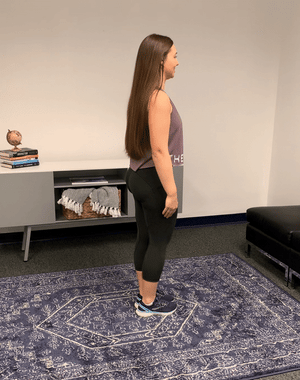
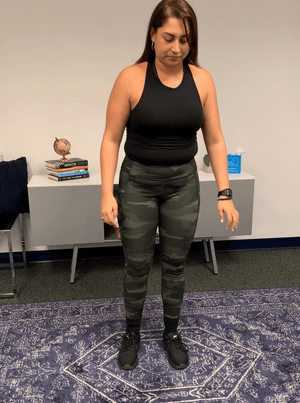
Tip #3: Visualize The Action
My personal advice for creating a successful habit? Envision yourself doing the exercises. Visualize yourself as someone who craves some sort of exercise and movement. To make this even more powerful, use all of your senses.
What will you see, smell or hear during a fun (but tough) physical workout? Think of how you will feel afterward: sweaty, accomplished, and strong.
Tip #4: Get Your Groove On
Make a fun workout playlist! Add songs that you love and only listen to them if you are working out, so that they feel like a reward. Music can be a great motivator, and also help activate your senses, getting you in the mood to move.
Tip #5: Watch TV While Exercising
On days you're feeling particularly unmotivated, try working out in front of the TV while watching your favorite show. Just be sure you don't get so distracted you lose proper form!
Tip #6: Choose Movement You Enjoy
No matter what type of movement you choose, always listen to your body and do what feels good. Exercise shouldn't feel like punishment. It should make you feel empowered and strong.
If you like running, run! If it's a kickboxing class, kick it! Maybe you need a restorative day, so do some yoga (try a PCOS Yoga pose) or use a foam roller.
It doesn’t matter if it’s Zumba at home, hopping on your exercise bike, strength training, or going to a group spin class - whatever you can keep up in your busy schedule and enjoy doing is what's right for you.
The Best Time to Start is Now
If you're just beginning your exercise journey, congratulations! Even if you feel unsure of what to do, that's okay - just focus on simplicity, enjoyment, and consistency for now.
Simply having the desire to move your body is the perfect place to begin. Don't be afraid to experiment, have fun, and discover new activities you can incorporate into your daily life.
An added perk? You'll likely find that your mental health starts to improve right alongside your physical health. Exercising when you have PCOS has been shown to improve so many physical and mental symptoms.
Remember that, in time, all your hard work will pay off. The sooner you take control of your health and wellness, the sooner you can control your PCOS symptoms, instead of feeling like PCOS has control over you.
Monica Moore is a board-certified Advanced Practice Nurse Practitioner, nurse educator and health coach who has been caring for patients at Illume Fertility for over 20 years. She is also the founder and lead educator at Fertile Health, LLC. Monica is passionate about taking care of the whole patient, believing in the importance of integrating comprehensive care. She has a special interest in PCOS and combating weight bias with education and advocacy.

